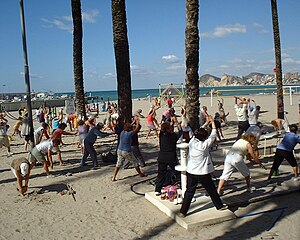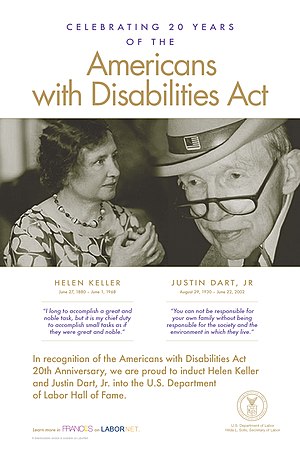
I spent all of last week in Scottsdale Arizona so I could be seen by dysautonomia expert Dr. Brent Goodman at the
Mayo Clinic. Beginning this week, I want to share with you my impressions of this experience. This was my very first time traveling outside of the Los Angeles metropolitan area to seek medical care.
Day One - Monday, March 14th
1:00 PM: I arrived right at my check-in time, delayed in getting there 15 minutes early by road construction along Shea Road. As we arrive, I see that the clinic building is a soft grayish-tan color that almost blends into the surrounding desert landscape. Robert heads for patient drop off curb at the front door, I get out and I hurry inside.
Just inside the sliding glass doors is a reception desk. The staff sitting there smile at me and ask me where I am going. "Third floor," I said. They let me know the elevators are on the other side of the wall and then a volunteer pops out from behind the desk to escort me there.
'Wow,' I think, 'That is some kind of service.'
It's a short elevator ride up to the top floor of the building. When I disembarked, I see a large waiting room half full of people. Ahead of me is two poles connected by rope line with a sign for Check-In on the left and Scheduling on the right. I get into the Check-In line and wait for the two people ahead of me to get called to the large oval desk where there are four smiling employees working the Check-In windows and four working Scheduling windows.
'Seems like everyone here has a smile on their face,' I note to myself. 'This must be a nice place to work.'
I present my appointment confirmation paperwork when I am finally called to the desk. The check-in is a breeze and I am asked to sit on the left side of the waiting room. By now, Robert has joined me, having no problems finding a parking space in the ample and free underground parking beneath the building. Then I am called to the far right window on scheduling side of the desk, which is registration. Since I pre-registered over the phone the week before, I just need to sign one form and present my photo ID and insurance cards.
As I am standing at the registration window, I hear my name called. "Here!" I say in response. The woman helping me lets the staff member calling my name know I am almost finished with my paperwork. I then go straight from the registration window to a exam room.
Sitting on a couch in an examination room, I get started on the three pages of forms I somehow neglected to complete in my appointment packet. I can only get a half page completed by the time Dr. Goodman arrives. For a patient who is used to waiting up to one hour to be seen by a doctor, I am quite amazed how on time they are here at the Mayo Clinic. Which means I need to make sure I get to any subsequent appointments on time, if not early.
After introductions the doctor asks me for my medical history. Like the professional patient that I am, I dive into my soliloquy, inviting the doctor to stop me and ask questions if I get off track along the way. He compliments me at the end of my story for giving such a complete and detailed history.
Next is the physical exam. He excuses himself from the room so I can disrobe and change into a hospital gown. He is gone long enough for me to work on the forms again, but I still don't have them done by the time he comes back. Once back in the room, he conducts one of the most complete exams I have had from a neurologist. Along the way, I am surprised to learn that I have problems telling the difference between sharp and dull pain stimuli; I silently chalk that up to my fibromyalgia which makes all pain seem bigger and stronger than it is.
He leaves the room again so I can change back into my clothes. This time, I finally finish those three pages of forms by the time he returns again. Now it's his turn to talk, explaining that I have three risk factors for dysautonomia: my previous cancer treatment, my chronic Hepatitis C infection and my type 2 diabetes. He's not sure if he can determine which ones are responsible, at which point I interject that I am not so concerned about that. I tell him what I really hope is that he can help me manage my symptoms better.
He wants to run several tests, including one to make sure that my symptoms aren't related to a particular type of cancer. 'I'll worry about cancer if the test comes back positive,' I think to myself. He is also putting in a referral to the Hepatology Department, asking for a consult on my Hepatitis C status. We end the visit with Dr. Goodman letting me know that we will meet again towards the end of the week to review the test results.
Robert and I walk back out to the waiting room. I ask him what he thinks so far and he's not sure yet. We both like Dr. Goodman, but Robert wants to reserve judgment until he sees what tests the doctor orders and what his recommendations are.
They call me from the Scheduling side of the desk and give me a pager. The staff person helping me lets me know Dr. Goodman has ordered eight different appointments for me and it's going to take some time to schedule all of them. When the scheduling is complete, the pager will go off, letting me know I need to head back to the desk and pick up my appointment schedule.
Robert and I spend most of the time in the waiting room, talking about our expectations and reviewing my first meeting with the doctor. Then we head down to the parking lot so I can grab a snack I left in the back seat of the car. The time seems to move quickly, and by the time we return to the waiting room, my pager is going off.
Up at the Scheduling window I am handed my "itinerary" for the week. They still need to schedule my follow up with Dr. Goodman and they are still trying to get me into the Hepatology Clinic, so I need to check back with them tomorrow for these appointments. As I stop to visit the ladies room on our way back to the car, Robert studies my itinerary and starts figuring out wake-up times, meals breaks and how much time to allocate to travel to and from the clinic.
Once back at the hotel room, I take a stab at refining his schedule, since some of the tests require either fasting or no eating and drinking for three to four hours beforehand.
It's a good thing I asked about how long I needed to stay in Arizona when I scheduled my appointment. I got very good advice when I was told to schedule my first appointment on Monday or Tuesday and then plan to keep the rest of the week open for tests and follow up. By the end of day one, I already know I have appointments for the next three days...
Come back and join me tomorrow. I'll be writing about my experiences with autonomic testing, catecholamine testing and an EMG and nerve conduction study.
 As you can see, I included a wrap-up section at the bottom of the form, a place to write down your thoughts on what worked, what didn't and what you'd like to try the next time. This section gives you a prompt to evaluate your experience so you can do better next time. And by better, I mean: have more fun, be more prepared, get more help, schedule more rest, avoid flare-ups, etc., etc., etc.
As you can see, I included a wrap-up section at the bottom of the form, a place to write down your thoughts on what worked, what didn't and what you'd like to try the next time. This section gives you a prompt to evaluate your experience so you can do better next time. And by better, I mean: have more fun, be more prepared, get more help, schedule more rest, avoid flare-ups, etc., etc., etc.

























